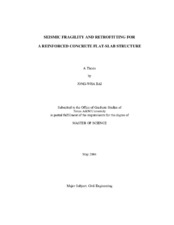| dc.description.abstract | The effectiveness of seismic retrofitting applied to enhance seismic performance was assessed for a five-story reinforced concrete (RC) flat-slab building structure in the central United States. In addition to this, an assessment of seismic fragility that relates the probability of exceeding a performance level to the earthquake intensity was conducted. The response of the structure was predicted using nonlinear static and dynamic analyses with synthetic ground motion records for the central U.S. region. In addition, two analytical approaches for nonlinear response analysis were compared. FEMA 356 (ASCE 2000) criteria were used to evaluate the seismic performance of the case study building. Two approaches of FEMA 356 were used for seismic evaluation: global-level and member-level using three performance levels (Immediate Occupancy, Life Safety and Collapse Prevention). In addition to these limit states, punching shear drift limits were also considered to establish an upper bound drift capacity limit for collapse prevention. Based on the seismic evaluation results, three possible retrofit techniques were applied to improve the seismic performance of the structure, including addition of shear walls, addition of RC column jackets, and confinement of the column plastic hinge zones using externally bonded steel plates. Finally, fragility relationships were developed for the existing and retrofitted structure using several performance levels. Fragility curves for the retrofitted structure were compared with those for the unretrofitted structure. For various performance levels to assess the fragility curves, FEMA global drift limits were compared with the drift limits based on the FEMA member-level criteria. In addition to this, performance levels which were based on additional quantitative limits were also considered and compared with FEMA drift limits. | en |


